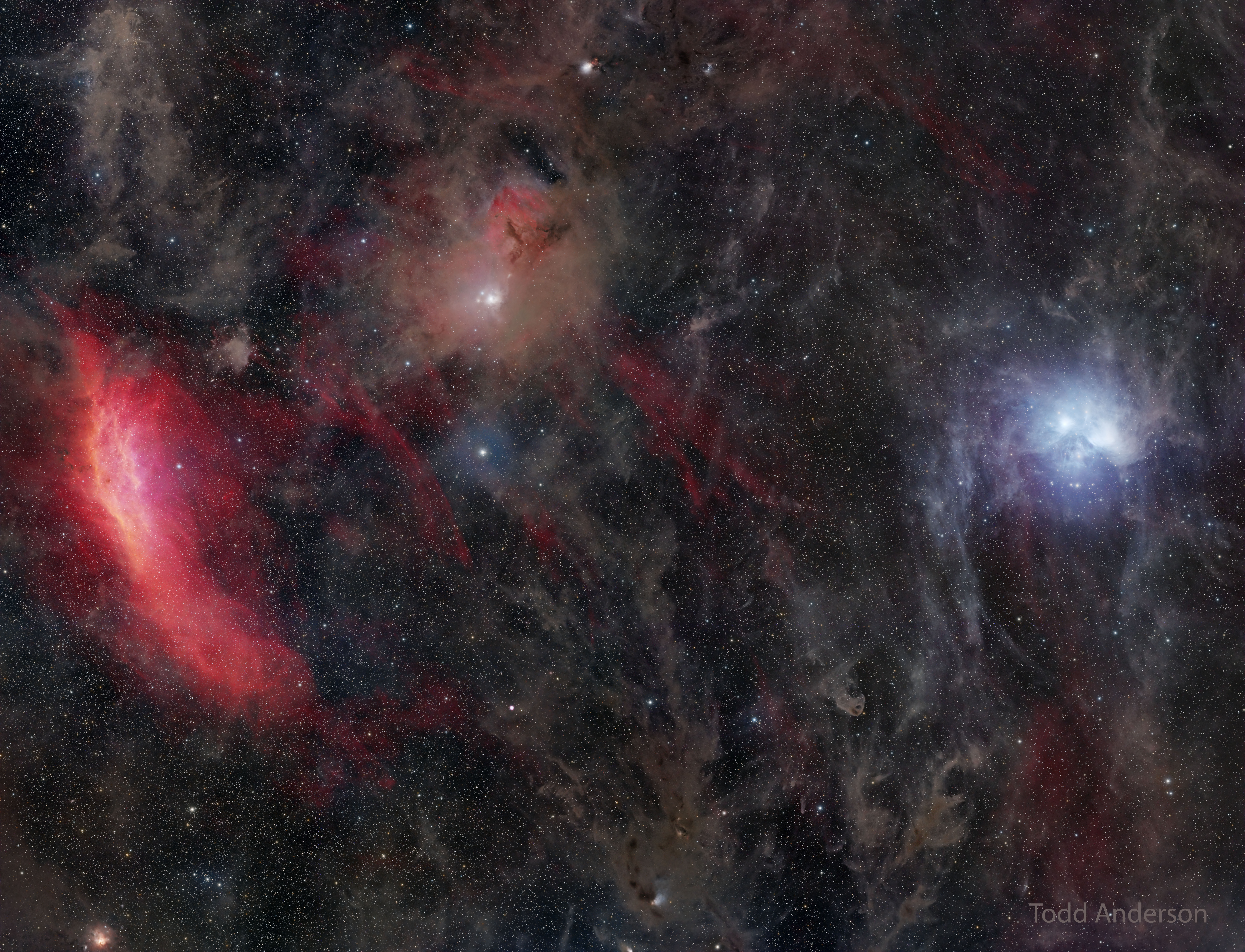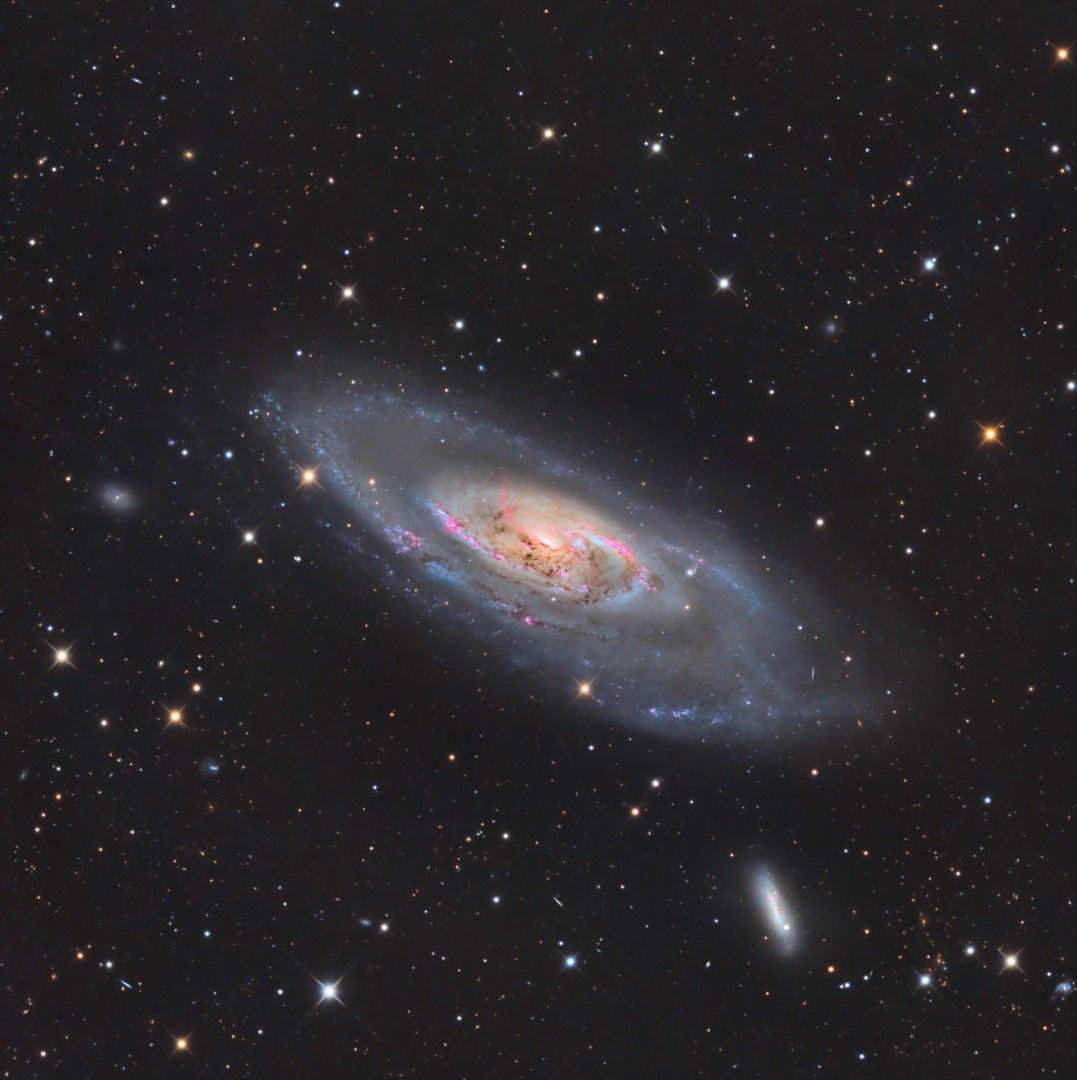Blog
Wilbur “Doc” Little (March 5, 1928 – May 4, 1987) was an American jazz bassist known for playing hard bop and post-bop.
Little originally played piano, but switched to double bass after serving in the military. In 1949 he moved to Washington, D.C., where he worked with “Sir” Charles Thompson, among others. After that, he was in J. J. Johnson‘s quintet from 1955 to 1958. He was the bassist on pianist Tommy Flanagan’s first studio album, recorded when he and Flanagan were touring in Europe as members of Johnson’s band.
Little moved to the Netherlands in 1977 and lived there for the rest of his life.
more...On the right, dressed in blue, is the Pleiades. Also known as the Seven Sisters and M45, the Pleiades is one of the brightest and most easily visible open clusters on the sky. The Pleiades contains over 3,000 stars, is about 400 light years away, and only 13 light years across. Surrounding the stars is a spectacular blue reflection nebula made of fine dust. A common legend is that one of the brighter stars faded since the cluster was named. On the left, shining in red, is the California Nebula. Named for its shape, the California Nebula is much dimmer and hence harder to see than the Pleiades. Also known as NGC 1499, this mass of red glowing hydrogen gas is about 1,500 light years away. Although about 25 full moons could fit between them, the featured wide angle, deep field image composite has captured them both. A careful inspection of the deep image will also reveal the star forming region IC 348 and the molecular cloud LBN 777 (the Baby Eagle Nebula).

Heitor Villa-Lobos (March 5, 1887 – November 17, 1959) was a Brazilian composer, conductor, cellist, and classical guitarist described as “the single most significant creative figure in 20th-century Brazilian art music”. Villa-Lobos has become the best-known South American composer of all time. A prolific composer, he wrote numerous orchestral, chamber, instrumental and vocal works, totaling over 2,000 works by his death in 1959. His music was influenced by both Brazilian folk music and stylistic elements from the European classical tradition, as exemplified by his Bachianas Brasileiras (Brazilian Bach-pieces) and his Chôros. His Etudes for classical guitar (1929) were dedicated to Andrés Segovia, while his 5 Preludes (1940) were dedicated to his spouse Arminda Neves d’Almeida, a.k.a. “Mindinha”. Both are important works in the classical guitar repertory.
more...J. B. Lenoir (/ləˈnɔːr/ luh-NORR; March 5, 1929 – April 29, 1967) was an American blues guitarist and singer-songwriter, active in the Chicago blues scene in the 1950s and 1960s.
Lenoir was born in Monticello, Mississippi. His full given name was simply “J. B.”; the letters were not initials. Lenoir’s guitar-playing father introduced him to the music of Blind Lemon Jefferson who became a major influence. During the early 1940s, Lenoir worked with the blues artists Sonny Boy Williamson II and Elmore James in New Orleans. He was later influenced by Arthur Crudup and Lightnin’ Hopkins.
Lenoir died on April 29, 1967, in Urbana, Illinois, at the age 38, of injuries he had suffered in a car crash three weeks earlier.
more...Louis A. Levy (March 5, 1928 – January 23, 2001) was an American jazz pianist.
Levy was born to Jewish parents in Chicago, Illinois, United States, and started to play the piano aged twelve. His chief influences were Art Tatum and Bud Powell.
A professional at age nineteen, Levy played with Georgie Auld (1947 and later), Sarah Vaughan, Chubby Jackson (1947–1948), Boyd Raeburn, Woody Herman’s Second Herd (1948–1950), Tommy Dorsey (1950) and Flip Phillips. Levy left music for a few years in the early 1950s and then returned to gain a strong reputation as an accompanist to singers, working with Peggy Lee (1955–1973), Ella Fitzgerald (1957–1962), June Christy, Anita O’Day and Pinky Winters. Levy also played with Dizzy Gillespie, Shorty Rogers, Stan Getz, Terry Gibbs, Benny Goodman, Supersax and most of the major West Coast players. Levy recorded as a leader for Nocturne (1954), RCA, Jubilee, Philips, Interplay (1977), and Verve.
Levy died of a heart attack in Dana Point, California at the age of 72.
more...Messier 106 (also known as NGC 4258) is an intermediate spiral galaxy in the constellation Canes Venatici. It was discovered by Pierre Méchain in 1781. M106 is at a distance of about 22 to 25 million light-years away from Earth. M106 contains an active nucleus classified as a Type 2 Seyfert, and the presence of a central supermassive black hole has been demonstrated from radio-wavelength observations of the rotation of a disk of molecular gas orbiting within the inner light-year around the black hole. NGC 4217 is a possible companion galaxy of Messier 106. Besides the two visible arms, it has two “anomalous arms” detectable using an X-ray telescope.

Eric Allandale (born Eric Allandale Dubuisson 4 March 1936 – 23 August 2001) was a trombonist, songwriter, and bandleader. During the 1960s, he was in number of bands in various genres which included jazz pop and soul.
A native of Dominica, West Indies, he moved to the U.K. in 1954 to complete his education. He joined the Hammersmith Borough Brass Band as a trumpeter while working as its council surveyor. He later switched to trombone and formed an amateur band playing jazz.
more...Willie Johnson (March 4, 1923 – February 26, 1995) was an American electric bluesguitarist. He is best known as the principal guitarist in Howlin’ Wolf‘s band from 1948 to 1953. His raucous, distorted guitar playing is prominent on Howlin’ Wolf’s Memphisrecordings during 1951–1953, including the hit song “How Many More Years” (recorded May 1951).
In 2017, Johnson was posthumously inducted in to the Blues Hall of Fame.
more...Halim Abdul Messieh El-Dabh (Arabic: حليم عبد المسيح الضبع, Ḥalīm ʻAbd al-Masīḥ al-Ḍabʻ; 4 March 1921 – 2 September 2017) was an Egyptian-American composer, musician, ethnomusicologist, and educator, who had a career spanning six decades. He is particularly known as an early pioneer of electronic music. In 1944 he composed one of the earliest known works of tape music, or musique concrète. From the late 1950s to early 1960s he produced influential work at the Columbia-Princeton Electronic Music Center.
more...Antonio Lucio Vivald (4 March 1678 – 28 July 1741) was an Italian composer, virtuoso violinist and impresario of Baroque music. Regarded as one of the greatest Baroque composers, Vivaldi’s influence during his lifetime was widespread across Europe, giving origin to many imitators and admirers. He pioneered many developments in orchestration, violin technique and programmatic music. He consolidated the emerging concerto form, especially the solo concerto, into a widely accepted and followed idiom.
Vivaldi composed many instrumental concertos, for the violin and a variety of other musical instruments, as well as sacred choral works and more than fifty operas. His best-known work is a series of violin concertos known as The Four Seasons. Many of his compositions were written for the all-female music ensemble of the Ospedale della Pietà, a home for abandoned children. Vivaldi began studying for the Catholic priesthood at the age of 15 and was ordained at 25, but was given dispensation to no longer say public Masses due to a health problem. Vivaldi also had some success with expensive stagings of his operas in Venice, Mantua and Vienna. After meeting the Emperor Charles VI, Vivaldi moved to Vienna, hoping for royal support. However, the Emperor died soon after Vivaldi’s arrival, and Vivaldi himself died in poverty less than a year later.
After almost two centuries of decline, Vivaldi’s musical reputation underwent a revival in the early 20th century, with much scholarly research devoted to his work. Many of Vivaldi’s compositions, once thought lost, have been rediscovered – some as recently as 2015.[7] His music remains widely popular in the present day and is regularly played all over the world.
more...Jan Garbarek (born 4 March 1947) is a Norwegian jazz saxophonist, who is also active in classical music and world music.
Garbarek was born in Mysen, Østfold, southeastern Norway, the only child of a former Polish prisoner of war, Czesław Garbarek, and a Norwegian woman. He grew up in Oslo, stateless until the age of seven, as there was no automatic grant of citizenship in Norway at the time. When he was 21, he married the author Vigdis Garbarek. He is the father of musician and composer Anja Garbarek.
more...Zenzile Miriam Makeba ( 4 March 1932 – 9 November 2008), nicknamed Mama Africa, was a South African singer, songwriter, actress, and civil rights activist. Associated with musical genres including Afropop, jazz, and world music, she was an advocate against apartheid and white-minority government in South Africa.
Born in Johannesburg to Swazi and Xhosa parents, Makeba was forced to find employment as a child after the death of her father. She had a brief and allegedly abusive first marriage at the age of 17, gave birth to her only child in 1950, and survived breast cancer. Her vocal talent had been recognized when she was a child, and she began singing professionally in the 1950s, with the Cuban Brothers, the Manhattan Brothers, and an all-woman group, the Skylarks, performing a mixture of jazz, traditional African melodies, and Western popular music. In 1959, Makeba had a brief role in the anti-apartheid film Come Back, Africa, which brought her international attention, and led to her performing in Venice, London, and New York City. In London, she met the American singer Harry Belafonte, who became a mentor and colleague. She moved to New York City, where she became immediately popular, and recorded her first solo album in 1960. Her attempt to return to South Africa that year for her mother’s funeral was prevented by the country’s government.
Makeba’s career flourished in the United States, and she released several albums and songs, her most popular being “Pata Pata” (1967). Along with Belafonte, she received a Grammy Award for Best Folk Recording for their 1965 album An Evening with Belafonte/Makeba. She testified against the South African government at the United Nations and became involved in the civil rights movement. She married Stokely Carmichael, a leader of the Black Panther Party, in 1968, and consequently lost support among white Americans. Her visa was revoked by the US government when she was traveling abroad, forcing her and Carmichael to relocate to Guinea. She continued to perform, mostly in African countries, including at several independence celebrations. She began to write and perform music more explicitly critical of apartheid; the 1977 song “Soweto Blues“, written by her former husband Hugh Masekela, was about the Soweto uprising. After apartheid was dismantled in 1990, Makeba returned to South Africa. She continued recording and performing, including a 1991 album with Nina Simone and Dizzy Gillespie, and appeared in the 1992 film Sarafina!. She was named an FAO Goodwill Ambassador in 1999, and campaigned for humanitarian causes. She died of a heart attack during a 2008 concert in Italy.
Makeba was among the first African musicians to receive worldwide recognition. She brought African music to a Western audience, and popularized the world music and Afropop genres. Despite her cosmopolitan background, she was frequently viewed by Western audiences as an embodiment of Africa: she was also seen as a style icon in both South Africa and the West. Makeba made popular several songs critical of apartheid, and became a symbol of opposition to the system, particularly after her right to return was revoked. Upon her death, former South African President Nelson Mandela said that “her music inspired a powerful sense of hope in all of us.”
more...More Posts
- Happy Juneteenth 2021
- The Cosmos with C/2016 R2
- Paul McCartney
- Sugarcane Harris
- Ahmad Jovdat Ismayil oglu Hajiyev
- Ray McKinley
- Benny Payne
- Flamenco Fridays with Cameron
- Daily Roots with Burning Spear
- The Cosmos with NGC 6888
- Dobet Gnahoré
- Chuck Rainey
- Igor Stravinsky
- Tony Scott
- World Music with Ágnes Herczku
- Daily Roots with Alexander Henry
- The Cosmos with Scorpius
- Eddie Levert
- Lucky Thompson
- Clarence Shaw


